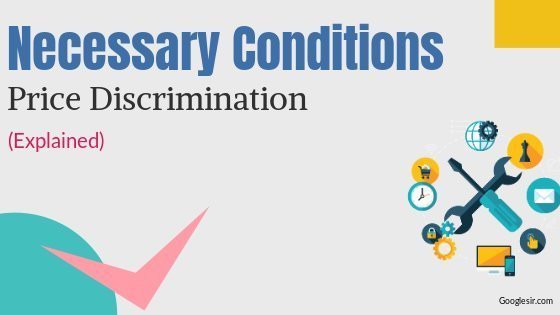Price discrimination refers strictly to the practice by a seller of simultaneously charging different prices to different buyers for the same goods.

Conditions for Price Discrimination
The policy of price discrimination can be adopted only when the following conditions are fulfilled:
1. Monopolistic Situation
The very first condition in which price discrimination policy can be adopted in the presence of a monopolistic situation in the market.
The policy of price discrimination is very commonly adopted when the manufacturer enjoys the situation of monopoly in the market.
RElated: 18 Reasons and Importance of Product Innovation (Explained).
2. Agreement with Competitors
A very common situation in which the policy of price discrimination can be adopted is the situation of monopoly created by making an agreement among all the competitors to charge a certain price for a product.
The is called created the situation of monopoly.
Under this, all the manufacturers of a product agree not to sell their product below a certain price.
They may agree to charge different consumers also.
Bonus: Selection of Target Market: 7 Things to Know Before Evaluating.
3. Sale on Order
If a manufacturer produces and sells the goods on orders only, he can charge different prices from different consumers because he has to deal with every consumer on different lines.
4. Ignorance of Consumers
Ignorance of consumers also provides an opportunity for the manufacturers to charge different prices from different consumers.
A manufacturer can take advantage of the ignorance of consumers and adopt the policy of price discrimination.
5. Elasticity of Demand of Different Markets
A product is sold in different segments of a market and the elasticity of demand of these segments may be different.
Based on such difference in the elasticity of demand, a manufacturer can adopt the policy of price discrimination and charge different prices from the consumers of different segments.
Related: 16 Need and Importance of Business Environment (Updated)
6. Difference in Purchasing Power of Consumers
When the consumers of a product belong to different groups of society and different income groups, the manufacturer can adopt the policy of price discrimination.

He can charge higher prices from the consumers of the high-income group and lower prices from the consumers of low-income groups.
7. Nature of Product
Nature of product also helps in adopting the policy or price discrimination.
If a product used for different purposes, the manufacturer may decide to charge different prices for such a product on the basis of its use.
Related: 10 Major Factors Affecting Pricing of Product (Explained).
8. Geographical Differences
If a product is sold in different segments of a market and these segments are at distance from each other, the policy of price discrimination can be adopted.
A manufacturer may fix different prices for the consumers of different segments.
9. Irrational Feeling of Consumers
Sometimes the feeling of the consumer becomes a reason for adopting the policy of price opinion that a product of higher price is better than a product pf lower price, he may adopt this policy.
10. Government Policy
Price discrimination is not only a result of the opinion and feeling of manufacturers but also the result of government policy.
Government policy determines different rates for different consumers for some specific products.
For example, the rates of electricity are different for industrial and domestic use. Similarly, the rates of sugar, wheat, cement, etc., are different for the purpose of rationing and open market.
Thus, now you know the necessary conditions for price discrimination.

